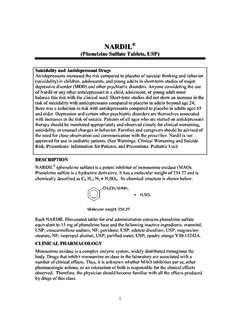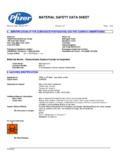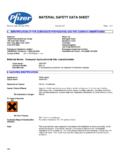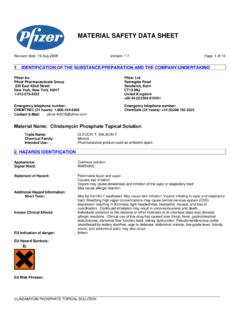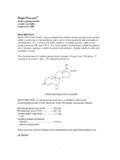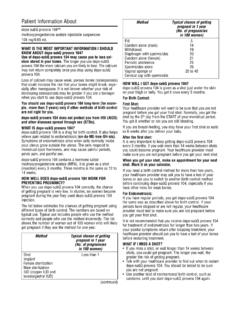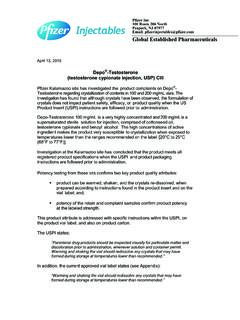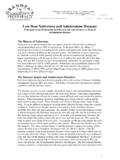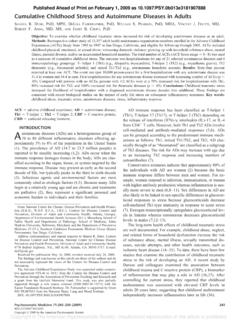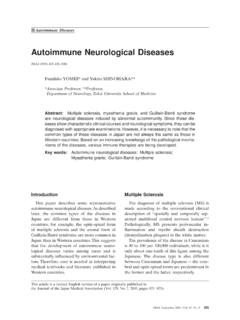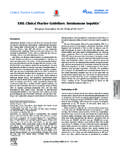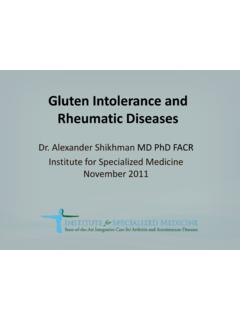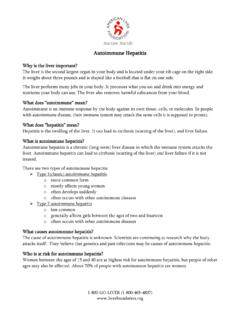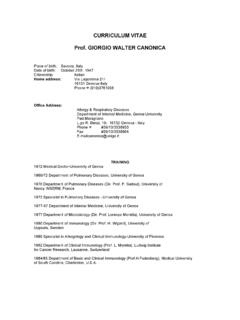Transcription of Chronic Inflammation and Inflammatory Disease - …
1 1 KEY TAKEAWAYSC hronic Inflammation is a primary contributing factor involved in multiple Chronic , the estimated prevalence of Chronic Inflammatory Disease in Western society is 5 to 7 Inflammatory Disease patients are at greater risk for developing another Inflammatory -related condition. In Europe the direct healthcare cost incurred by patients affected by IBD, have been estimated to be billion per is a critical response to potential danger signals and damage in organs in our body. In diseases such as rheumatoid arthritis, lupus, ulcerative colitis, Crohn s Disease and others, the immune system turns against the bodies organs. These painful and, in some cases, progresively debilitating conditions can take a toll on people s quality of life and create both societal and economic Inflammatory process in the body serves an important function in the control and repair of injury.
2 Commonly referred to as the Inflammatory cascade, or simply Inflammation , it can take two basic forms, acute and Chronic . Acute Inflammation , part of the immune response, is the body s immediate response to injury or assault due to physical trauma, infection, stress, or a combination of all three. Acute Inflammation helps to prevent further injury and facilitates the healing and recovery Inflammation becomes self-perpetuating however, it can result in Chronic or long-term Inflammation . This is known as Chronic Inflammation , and lasts beyond the actual injury; sometimes for months or even years. It can become a problem itself, and require medical intervention to control or stop further Inflammation -mediated Inflammation can affect any and all parts of the body. Inflammation can also be a secondary component of many diseases.
3 For example, in atherosclerosis, or hardening of the arteries where, Chronic Inflammation of blood vessel walls can result in plaque buildup in the arteries, arterial or vascular blockages, and heart Chronic Inflammation also plays a significant role in other diseases and conditions as well; Chronic pain, poor sleep quality, obesity, physical impairment, and overall decreased quality of Chronic Inflammation MAY ALSO SERVE AS A PRECURSOR TO CERTAIN CANCERS. PERSISTENT Inflammation IS ASSOCIATED WITH DNA DAMAGE, WHICH IN TURN CAN LEAD TO FOR EXAMPLE, PEOPLE WITH Chronic Inflammatory BOWEL DISEASES (IBD), SUCH AS ULCERATIVE COLITIS (UC) AND CROHN S Disease (CD), HAVE AN INCREASED RISK OF COLON the large and broad array of negative consequences listed above, it is not surprising that Chronic Inflammation can have an extensive burden on society.
4 In a recent population-based study that reviewed multiple markers of Chronic Inflammation , the authors found evidence that supported the causative role of Chronic Inflammation in the link between social isolation and Societal and Economic Burden of Chronic InflammationThe evidence suggests that the number of people suffering from Chronic diseases such as cardiovascular diseases, diabetes, respiratory diseases, autoimmune diseases, and cancers has increased dramatically over the last three decades. The increasing rates of these illnesses suggest that Chronic Inflammation , caused by excessive and inappropriate Inflammatory activity, which in turn leads to Chronic Inflammatory activation in the body, can be a contributing factor in BURDEN OF DISEASEC hronic Inflammation and Inflammatory Disease2the pathology of these ,7,8,9 There is further evidence suggesting that successful treatment of Chronic Inflammation ( , reduction of Inflammation ) might reduce the risk of cardiovascular While it is difficult to measure the precise economic impact ofchronic Inflammation since this impact spans into almost allareas of Chronic Disease , we can look at some specific chronicinflammation-mediated diseases.
5 For example: In Europe thedirect healthcare cost incurred by patients affected by IBD,have been estimated to be billion per Health disparities in Chronic Inflammatory Disease arewidespread; for example, black Americans are at 3 to 4 timeshigher risk for morbidity and mortality associated with chronickidney Disease compared to white In 2010, the cost of Chronic obstructive pulmonary Disease (COPD) in the was projected to be approximately$50 billion, which includes $30 billion in direct health careexpenditures and $20 billion in indirect Economic burden to the NHS due to COPD was estimatedat 982 million pounds in direct and indirect costs annual cost of treating COPD in Europe is estimated to be Chronic diseases can exacerbate symptoms of depression, anddepressive disorders themselves, and can lead to Chronic Arthritis (RA)Rheumatoid arthritis (RA) is a Chronic , systemic (potentially reaching the whole body)
6 Inflammatory disorder that typically affects the small joints in hands and feet. RA is an autoimmune Disease , where a person s immune system attacks joint tissues and potentially other body parts/organs for unknown reasons. As the Disease progresses, symptoms may spread to the wrists, knees, ankles, elbows, hips, and shoulders. As a result, RA causes pain, Inflammation , and eventually joint damage and malformation. RA can cause people to feel sick, tired, and feverish; it also damages joints symmetrically, where joint pain is felt on both sides of the RA differs greatly from osteoarthritis (OA), which is a degenerative joint Disease that only limits joint affects approximately million people in the and approximately million people worldwide; RA can occur at any In fact, approximately 294,000 children under the age of 18 in the were affected by pediatric arthritis and rheumatologic In women, the most common age of onset is between 30 and 60, while it often occurs later in life for Nearly three times as many women are affected by RA compared to study examining self-reported quality of life found that compared to those without arthritis, RA patients were 40 percent more likely to report poor or fair general health, 30 percent more likely to need help with personal care, and twice as likely to have a health-related activity study in 2010 found that the annual out-of-pocket costs were $1,193 for patients with RA, with annual excess out-of-pocket costs of $510 per privately insured In the same study.
7 The annual total costs for the privately insured and the Medicare populations were estimated to be $306 million and $600 million, respectively. Excess per-patient costs for uninsured RA patients were estimated to be $5,758, which, when weighted by the uninsured prevalence, aggregates to an annual total cost of $560 ,25In the , the National Audit Office (NAO) estimated that in 2009, RA cost the National Health Service (NHS) around 560 million a year, with the majority of this in the acute sector, and that the additional cost to the economy of sick leave and work-related disability was billion a Results from a 2011 study indicate that an increase in earlier treatment for RA patients could produce significant benefits in terms of productivity, with gains of 31 million for the economy due to reduced sick leave and lost Patients with Chronic Inflammatory conditions in the spend approximately$38,000 moreon additional expenditures each 6 MAnnual Mean Cost$6,204 (USD) per patient36 Rheumatoid Arthritis3 Prevalence181.
8 3 MAnnual Mean Cost$3,638 (USD) per patient36 Psoriatic Arthritisemployment. According to the s NAO, 10 percent of patients with RA are treated within 3 months of symptom onset; economic modelling suggests that increasing this to 20 percent would initially cause an increase in costs, but earlier treatment could become cost-neutral after nearly 9 Arthritis (PsA)Psoriatic arthritis (PsA) is a form of Inflammatory arthritis, which is a Chronic , autoimmune Disease that can be severe at Approximately 30 percent of patients who have the Chronic skin condition psoriasis will also develop psoriatic ,29 Patients who suffer from PsA Inflammation suffer from painful swelling in the joints of the hands and In addition, PsA can also cause changes to the nails, such as pitting or separation from the nail The resulting prolonged Inflammation eventually leads to joint damage.
9 Thus early diagnosis and treatment is necessary to slow and/or prevent joint PsA affects approximately 3 million people in the and Europe The most recent epidemiological study indicated that PsA affects an estimated million patients in the population, and many rate it as a large problem in everyday The prevalence may be even higher because PsA is often misdiagnosed or altogether ,34 The onset of PsA typically occurs between the ages 30 and Men and women are equally affected by this condition, and it is more common among Caucasians than Africans or imposes a considerable economic and quality-of-life burden to patients and society, and can contribute to reduced physical and psychosocial health-related quality of life. Many patients also report physical limitations, impaired emotional well-being, and general fatigue due to their This in turn results in direct medical costs from the utilization of health care resources.
10 The resulting functional limitations add to indirect costs such as disability and lost productivity and are substantial drivers of the total costs of care. In the , direct annual health care costs for PsA are estimated to be as high as $ billion, based on a mean cost per patient of $3, A European study showed an average direct cost of $4,008 in Bowel Disease (IBD) including ulcerative colitis (UC) and Crohn s Disease (CD) Inflammatory bowel Disease (IBD) describes conditions with Chronic or recurring immune response and Inflammation of the gastrointestinal (GI) The two most common Inflammatory bowel diseases are ulcerative colitis (UC) and Crohn s Disease (CD). UC specifically affects the large intestine whereas CD can affect any part of the GI of UC frequently include blood- and mucus-containing diarrhea, severe cramp-like abdominal pain, anemia, loss of appetite, weight loss, fatigue, severe urgency to have a bowel movement, and tenesmus (the feeling of incomplete evacuation).
